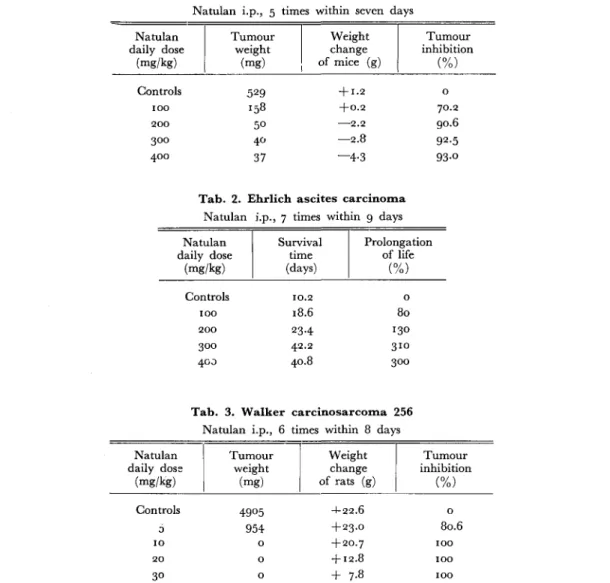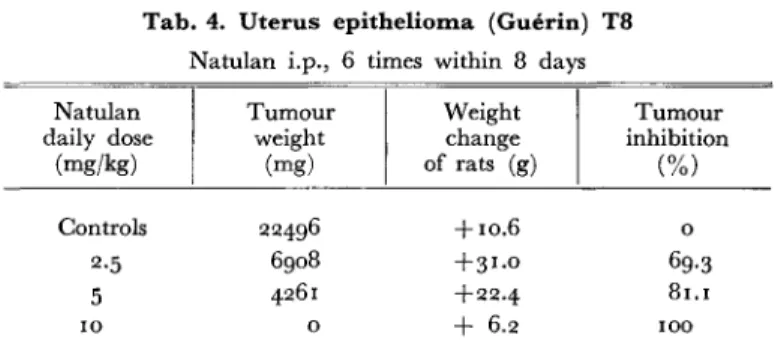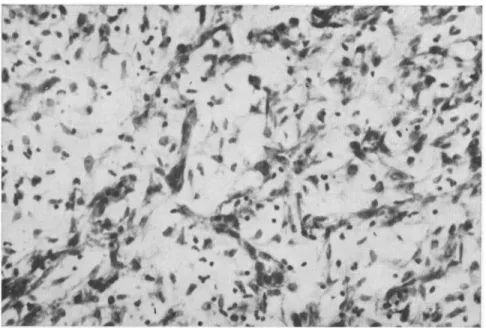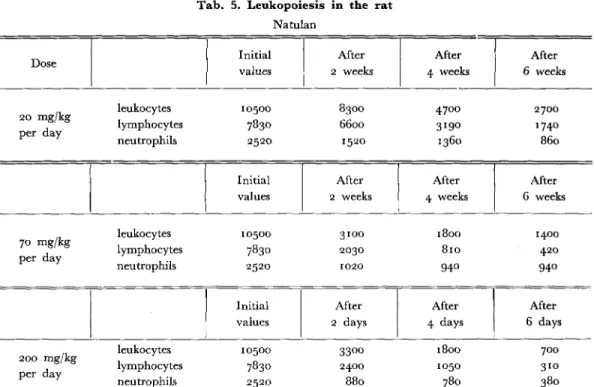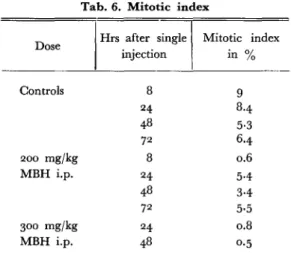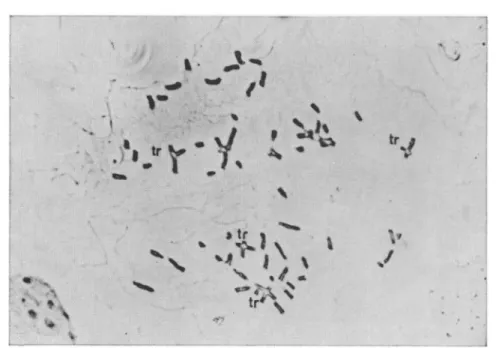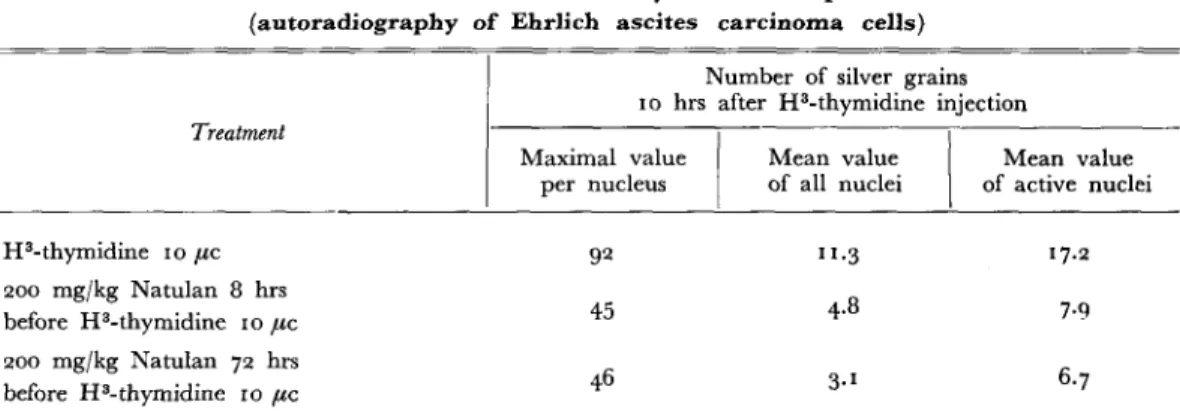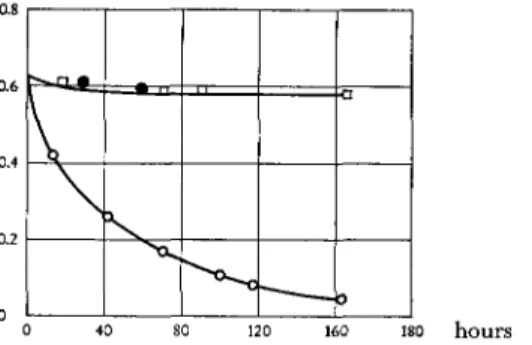Experimental Studies with Methylhydrazine Derivatives
W. Bollag
Methylhydrazine compounds constitute a new class of antitumour substances whose mechanism of action appears to be different from that of other cytotoxic agents.
Among a large series of hydrazines and hydrazides which have been synthesized in search of monoamine oxidase inhibitors, the first derivative found to possess a cer-tain antitumour activity was i-methyl-2-benzyl-hydrazine (Bollag and Grunberg, 1963):
- C H2N H N H C H3
This compound which showed pronounced inhibition of several transplantable tumours in mice and rats had, however, a low therapeutic index and, furthermore, caused liver damage.
Zeller et al. (1963), therefore, synthesized a large series of hydrazines in order to obtain a compound with better chemotherapeutic activity and lower toxicity. T h e systematic variation of the molecule revealed that active representatives of this chemical group were only found among compounds of the general formula:
R - C H2N H N H C H3
T h e biological properties within this group showed a marked variation depending on the chemical structure of the radical R.
Effect o n t r a n s p l a n t a b l e t u m o u r s
T h e methylhydrazine compounds were systematically tested on the following transplantable tumours: Ehrlich carcinoma, solid form, Ehrlich carcinoma, ascitic form and Crocker sarcoma S 180 in mice; Walker carcinosarcoma 256 and uterus epithelioma (Guerin) T 8 in rats. The growth of these tumours is markedly
influenc-ed by many methylhydrazine derivatives. Among these, Ro 4-6467/1 = p-(N1
-methylhydrazinomethyl)-N-isopropyl benzamide hydrochloride or Natulan (Bollag, J
963, 1964) exhibited a particularly favourable therapeutic index.
o
Proceedings of the First International Symposium on Antimitotics
Natulan (Ro 4-6467/1):
C H , C H ,
)CH N H C O
r\
C H , N H N H C H , - HC1Tables 1-4 show the inhibitory activity of Natulan on Ehrlich carcinoma, solid form, Ehrlich carcinoma, ascitic form, Walker carcinosarcoma 256, and uterus epithelioma (Guerin) T 8 .
Tab. 1. Ehrlich carcinoma, solid f o r m
Natulan i.p., 5 times within seven days Natulan daily dose (mg/kg) Controls 1 0 0 2 0 0 300 4 0 0 Tumour weight (mg) 529 158 5° 40 37 Weight change of mice (g) + 1.2 + 0 . 2 —2.2 —2.8 —4-3 Tumour inhibition (%) 0 70.2 90.6 92-5 93-o
Tab. 2. Ehrlich ascites carcinoma
Natulan i.p., 7 times within 9 days Natulan daily dose (mg/kg) Controls 1 0 0 2 0 0 300 4 0 0 Survival time (days) 10.2 18.6 23-4 42.2 40.8 Prolongation of life (%) 0 80 130 310 300
Tab. 3. Walker carcinosarcoma 256
Natulan i.p., 6 times within 8 days Natulan daily dose (mg/kg) Controls 0 1 0 2 0 3° Tumour weight (mg) 4905 954 0 0 0 Weight change of rats (g) 4-22.6 + 23.0 + 20.7 + 12.8 + 7-8 Tumour inhibition (%) 0 80.6 1 0 0 1 0 0 1 0 0 159
Tab. 4. Uterus epithelioma (Guerin) T8
Natulan i.p., 6 times within 8 days Natulan daily dose (mg/kg) Controls 2-5 5 IO Tumour weight (mg) 22496 6908 4261 0 Weight change of rats (g) + 10.6 + 31.0 + 22.4 + 6.2 Tumour inhibition (%) 0 69-3 81.1 1 0 0
Natulan exerts a particularly marked inhibition on transplantable tumours in rats. In experiments with treatment beginning on the day after implantation, the growth of the Walker carcinosarcoma and of the uterus epithelioma T8 was com-pletely suppressed by non-toxic doses. Natulan is not only effective when treatment has begun before the take of the tumour, it also exerts a therapeutic effect on well established tumours. If treatment of Walker tumours has begun as late as 5 days after implantation, i.e. when the tumour has already reached the size of an almond, a regression can be obtained. T h e regression of such tumours can be followed by his-tological examination.
Figs. 1 and 2 show that after treatment with Natulan the number of tumour cells already decreases markedly during the first 3 days. T h e tumour tissue is replaced by inflammatory tissue and finally by fibrous tissue.
In some of the animals this regression is complete and no recurrence is observed within a period of 100 days. However, in other animals, although regression to al-most non palpable nodules is obtained, this is only temporary, as tumour growth reappears in spite of continued treatment.
With the Walker carcinosarcoma, drug resistance can develop within the same generation, whereas with Ehrlich carcinoma drug resistance could be observed only after continued treatment of 7 to 9 generations of inoculated mice.
Effect o f N a t u l a n o n o t h e r r a p i d l y p r o l i f e r a t i n g t i s s u e s
Like all other antitumour agents, Natulan does not act selectively on tumour tissue. Other rapidly proliferating tissues such as the haemopoietic tissues, the ger-minal epithelium and the hair follicles are also affected (Bollag and Theiss, 1964).
Natulan exerts a considerable effect on haemopoiesis. All blood-forming systems are affected. Leukopoiesis and thrombopoiesis are markedly damaged while the erythro-poiesis is influenced much less. Both lines of white blood cells, the myeloid and the lymphoid series, are depressed by Natulan. Depending on the species used, the in-fluence on leukopoiesis varies considerably. Thus Natulan predominantly depresses the granulopoiesis in dogs, while in rats it mainly affects the lymphopoiesis.
Walker tumour control
Fig. i. Histological section of the peripheral zone of a Walker tumour, 8 days after implantation. The tumour tissue is in full proliferation. Many cells in mitosis. (Hematoxylin-eosin, magnification X 400)
Walker tumour
after 3 days' treatment with Natulan
Fig. 2. Histological section of the peripheral zone of a Walker tumour, 8 days after implantation. Due to treat-ment, the tumour cells have almost disappeared. Replacement of the tumour tissue by granulation tissue and
T a b . 5 shows the effect of Natulan on the leukopoiesis in rats. Tab. 5. Leukopoiesis in the rat
Natulan Dose Initial values After 2 weeks After 4 weeks After 6 weeks 20 mg/kg per day leukocytes lymphocytes neutrophils 10500 7830 2520 8300 6 6 0 0 1520 4700 3!9° 1360 2700 1740 8 6 0 Initial values After 2 weeks After 4 weeks After G weeks 70 mg/kg per day leukocytes lymphocytes neutrophils 10500 7830 2520 3100 2030 1020 1800 8 1 0 9 4 0 1400 4 2 0 940 Initial values After 2 days After 4 days After 6 days leukocytes lymphocytes neutrophils 10500 7830 2520 33°o 2400 8 8 0 1800 1050 780 7 0 0 3 1 0 3 8 0 200 mg/kg per day
Haemolysis is a manifestation of toxicity common to many hydrazine derivatives. It is due to the formation of methaemoglobin and the appearance of Heinz-Ehrlich inclusion bodies in the erythrocytes. As a consequence of haemolysis, reticulocytosis and storage of haemosiderin in various organs are observed.
M e c h a n i s m o f a c t i o n o f m e t h y l h y d r a z i n e d e r i v a t i v e s
I. CYTOLOGIGAL STUDIES A. Ehrlich ascites carcinoma
Cytological studies revealed that the substances belonging to the group of methyl-hydrazine derivatives exert a marked influence on the mitotic cycle (Rutishauser and Bollag, 1963). T h e experiments were carried out on Ehrlich ascites carcinoma. T h e tumour used has a rather stable chromosomal variation pattern with a stemline chromosome number of 66. This hypertriploid tumour with 2 metacentric marker chromosomes showed no spontaneous chromosome or chromatid breaks.
Proceedings of the First International Symposium on Antimitotics i. Mitotic index
Under the influence of methylbenzylhydrazine (MBH) the mitotic index decreases very markedly. T h e mitotic index in the non-treated controls varies between 5.3% and 9 % . In the treated animals, depending on the dose of the cytotoxic agent and the lapse of time after its administration, the index falls to a minimum of 0.5 to 0.6%, i.e. to about 1/10 of the control values (Tab. 6).
Tab. 6. Mitotic index
Dose Hrs after single injection Mitotic index in % Controls 8 9 24 8.4 48 5-3 72 6.4 200 mg/kg 8 0.6 MBH i.p. 24 5.4 48 3.4 72 5-5 300 mg/kg 24 0.8 MBH i.p. 48 0.5 2. Phase ratio
T h e analysis of the different phases of the mitotic cycle shows a slight shift from prophase to metaphase. T h e percentage of ana- and telophases does not change significantly.
3. Chromosome number
The number of chromosomes in our hypertriploid ascites tumour with its stem-line number (S) of 66 does not show any alteration in its chromosome variation pat-tern under the influence of M B H .
4. Chromosomal aberrations
After the treatment with methylhydrazine derivatives a high number of chromo-somal aberrations occurs. A few free chromatid breaks can be observed, however interchange and triradial recombinations prevail by far (Fig. 3).
S >
V
Fig. 3. Metaphase plate, 48 hrs after 400 mg/kg MBH. Chromosomal aberrations, in which some of the re-combinations are pointed out as tr = translocation (interchange)
The number of breaks depends on the dose of the drug and the lapse of time after the injection of methylhydrazine derivatives. I n the next T a b . 7 the mean percentage of chromatid breaks is indicated. 1% breaks mean that in one of 100 investigated metaphase plates one chromatid break is found. In our calculation an interchange form is counted e.g. as 4, as this recombination is the consequence of 4 chromatid breaks.
Tab. 7. Chromatid breaks
Dose Hrs after single injection Mean percentage of breaks C o n t r o l s 200 m g / k g MBH i.p. 4 0 0 m g / k g MBH i.p. 8 24 48 72 48 72 168 192 0 0 3-3 38.0 29.0 70.4 280.0 255-6 39-6
Proceedings of the First International Symposium on Antimitotics From these results the following conclusions were drawn:
The low mitotic index is interpreted as a suppression of mitosis brought about by a prolongation of the interphase. As the slight shift in distribution from prophase to metaphase is not followed by a decrease of ana- and telophase and is furthermore combined with a low mitotic index, a colchicine-like effect can be excluded. T h e chromosomal aberrations induced by the methylhydrazine derivatives show a spe-cific pattern. Only chromatid breaks and chromatid reunions but no chromosome breakage could be observed. From this fact it may be inferred that the breaks are induced during or after deoxyribonucleic acid synthesis, i.e. either in the S or the G2 phase. Under the treatment with methylhydrazine derivatives there is no change in the chromosome number. This may imply that the cells presenting chromosomal aberrations are no more viable and do not survive the next cycle.
B. Tissue culture
The effect of methylhydrazine derivatives on tissue culture has been examined by several authors (Mosimann, Staiger, Rutishauser). I n contrast to the definite effect of Natulan on mitosis and chromosomes in vivo, its influence on cells in tissue culture is very weak. A certain inhibitory effect on the growth of tissue cultures of Hela- and KB-cells has been seen, but only with the high doses of ioo to iooo y/ml medium. Primary rat kidney tissue cultures and tissue cultures of the h u m a n carci-noma H E P 2 were hardly inhibited in their growth by Natulan. In primary rat kidney tissue culture 2000 y/ml did not induce any chromosomal aberrations. The enormous dose of 4000 y/ml did not interfere with the growth of H E P 2 cultures and induced only a very few chromosome breaks, however no chromatid breaks and no reunions. This discrepancy between the results in vitro and in vivo may be explained by the hypothesis that only a metabolite of Natulan exerts the cytotoxic effect. The azo-derivative of Natulan, the only metabolite known to be effective in tumour inhibi-tion experiments in vivo has been examined but has been found inactive in tissue culture. Thus we do not yet know the reason for the almost complete inactivity of Natulan in vitro.
C. Autoradiographic studies
The above-mentioned studies had revealed that the sensitive period of the cell is either the S or G2 period of the interphase. Further investigations were carried out on Ehrlich ascites carcinoma cells for obtaining information on the effect of Natulan on the DNA synthesis (Rutishauser and Bollag, 1967). We measured the
incorpora-tion of H3-thymidine in the D N A of the nucleus by autoradiography. H'-thymidine
in a dose of 10 JJLC was administered to ascites tumour bearing mice. Ascites was
taken 10 hrs after injection of H3-thymidine. Natulan was given at different intervals
before the administration of H3-thymidine. From T a b . 8 it can be seen that Natulan
has a marked effect on the incorporation of H3-thymidine into DNA.
Tab. 8. Effect of Natulan on thymidine incorporation (autoradiography of Ehrlich ascites carcinoma cells)
H3-thymid 200 mg/kg before H3 -200 mg/kg before H3 -Treatment ne 10 fie Natulan 8 hrs thymidine 10 JJLC Natulan 72 hrs thymidine 10 /uc
Number of silver grains 10 hrs after H3-thymidine injection Maximal value per nucleus 92 45 46 Mean value of all nuclei 11.3 4.8 3-i Mean value of active nuclei 17.2 7-9 6.7
When Natulan was given 72 hrs before H3-thymidine the number of silver grains
in the area of the nucleus decreased from 11.3 to 3.1 if we count all nuclei, or from 17.2 to 6.7 if we count only the active nuclei. These latter nuclei undergoing the synthesizing period of the interphase constitute about 6 0 % of all nuclei. Further-more the highest number of silver grains in the controls amounts to 92 per nucleus, whereas the nuclei of Natulan treated animals reach only values of 46 per nucleus. From these results the conclusion can be drawn that the DNA synthesis is markedly inhibited, the percentage of inhibition ranging between 50 and 7 0 % .
These results are in good agreement with findings of other authors, who observed with other methods and on other tissues a marked inhibition of DNA synthesis by Natulan (Folsch et al., 1964; Weitzel; Trepel et al.).
I I . BIOCHEMICAL AND PHYSIOCHEMICAL STUDIES
We have just dealt with the inhibition of the synthesis of DNA by Natulan, which may be one of the possible mechanisms responsible for the cytotoxic activity. Many more factors may play a decisive role. Thus not only the deoxyribonucleic acid syn-thesis but also the ribonucleic acid synsyn-thesis is inhibited (Weitzel; Trepel et al., 1966). Furthermore it has been established that Natulan interferes markedly with protein synthesis (Folsch et al., 1964; Koblet).
Since the influence on the chromosomes is probably focussed on their main con-stituent which is the deoxyribonucleic acid, in vitro studies have been performed with the latter (Berneis et al., 1963, 1964; Brookes, 1965). It is well known that the in-fluence of radiation and alkylating agents cause the degradation of DNA whereby it is split into smaller fragments. T h e methylhydrazine derivatives likewise act by fragmentation of D N A b u t unlike nitrogen mustards only in the presence of oxygen.
Proceedings of the First I n t e r n a t i o n a l Symposium on Antimitotics
U n d e r Natulan treatment D N A remains intact in a nitrogen medium. These effects measured by the viscosity of aqueous DNA or by determining its molecular weight, are due to autoxidation of the methylhydrazine derivatives leading to the formation of hydrogen peroxide or O H radicals. The degradation of DNA in oxygen medium can be inhibited by addition of catalase (Fig. 4).
0.8 0.6 0.4 0.2
0 40 80 120 160 180 hours
Fig. 4. Changes in the specific viscosity of a 0.07% DNA solution containing 0.0005 rnol/1 Natulan O = in air # = in nitrogen
• = in air with addition of catalase
By other experiments it could be proven that the methylhydrazine derivatives promote reactions between peroxidic radicals and organic compounds such as for instance the deoxyribose (Berneis et al., 1964).
T h e depolymerizing effect on DNA could not yet be confirmed in experiments in vivo (Koblet). However the methods available for such a proof may not be ade-quate for discovering minor differences in weight and shape of DNA molecules.
Natulan may also act by an alkylating mechanism. Brookes (1965) demonstrated, by using H "-labelled Natulan, that a methyl group of Natulan is transferred to the guanine part of DNA, thus methylating guanine to 7-methylguanine. This alkylation could be achieved only in vivo in the Ehrlich ascites carcinoma, but — unlike the nitrogen mustards — not in vitro, in the test tube or in tissue culture. Kreis et al.
(1966) found in the urine of mice bearing Leukemia P 815 treated with C14-labelled
Natulan not only large quantities of 7-methylguanine b u t in addition i-methylade-nine and i-methylhypoxanthine.
The methylation of the purine bases of DNA (guanine and adenine) may change the genetic code of the cells and disturb in this way the reduplication of DNA and the synthesis of R N A and proteins necessary for growth. Many more investigations point to the fact that the mechanism of action of methylhydrazine derivatives differs from that of other cytotoxic agents (Weitzel et al., 1964; Obrecht et al., 1964).
In summarising it may be said that the methylhydrazine derivatives are known to possess a marked influence on preexisting DNA, as well as on the synthesis of DNA,
^ a j .
v
\J
\ ^
a
R N A and proteins, but that we ignore the exact mechanism responsible for the cy-totoxic effect. Anyhow the mechanism of action must be different from that of other antitumour agents, as there does not exist a cross-resistance between Natulan and any compound of another class of cytotoxic agents.
S u m m a r y
Natulan (Procarbazine) is a methylhydrazine derivative which in animal exper-iments inhibits a series of transplantable tumours. T h e Walker carcinoma is mark-edly affected. Even well established Walker tumours disappear completely under Natulan treatment. T u m o u r tissue is replaced by fibrous tissue. Natulan does not act selectively on neoplastic tissue, it also depresses the growth of other rapidly proliferating tissues such as the bone marrow.
As regards the mechanism of action the following data are known: Natulan lowers the mitotic index by prolonging the interphase and hindering the cell from entering into mitosis. In Ehrlich ascites tumour cells chromatid breaks were observed. Natulan depolymerizes deoxyribonucleic acid (DNA) in vitro. In vivo the synthesis of DNA is inhibited. Furthermore alkylation of purine bases has been demonstrat-ed. All these mechanisms may be responsible for the cytotoxic effect of methyl-hydrazine derivatives. Natulan does not possess cross-resistance towards other cy-totoxic agents. This phenomenon is a further proof of its particular mechanism of action.
R e f e r e n c e s
BERNEIS K. et al. (1963). Der pro-oxydative Effekt tumorhemmender Methylhydrazin-Verbindungen. Helv. Chim. Acta, 46: 2157-2167.
(1963). The degradation of deoxyribonucleic acid by new tumor inhibiting compounds: the inter-mediate formation of hydrogen peroxide. Experientia, 19: 132-133.
(1964). Die Auslosung von Fenton-Reaktionen durch cytotoxische Methylhydrazin-Verbindungen. Helv. Chim. Acta, 4 7 : 1903-1911.
BOLLAG W. (1963). The tumor-inhibitory effects of the methylhydrazine derivative Ro 4-6467/1 (NSG-77213). Cancer Chemother. Rep., 3 3 : 1-4.
— (1964). Investigations with methylhydrazine derivatives. In: Chemotherapy of Cancer. Ed. Plattner. Else-vier, Amsterdam, London, New York, 191-197.
— GRUNBERG E. (1963). Tumor inhibitory effects of a new class of cytotoxic agents: methylhydrazine deriv-atives. Experientia, 19: 130-131.
— THEISS E. (1964). Selective toxicity of antitumor agents: methylhydrazine derivatives. In: Chemotherapy of Cancer. Ed. Plattner. Elsevier, Amsterdam, London, New York, 311-313.
BROOKES P. (1965). Studies on the mode of action of ibenzmethyzine. In: Natulan. Ed. Jelliffe and Marks. Wright & Sons, Bristol, 9-12.
FOLSCH E. et al. (1964). Ober die Wirkung eines neuen Cytostaticums (Ro 4-6467) auf den Einbau markierten Glycins in Tumorzellen. Verh. Deutsch. Ges. Inn. Med., 70: 995-998.
KOBLET H. Personal Communication.
KREIS W. et al. (ig66). Studies on the metabolic fate of the Ci4-labelled methyl group of a methylhydrazine derivative in P 815 mouse leukemia. Experientia, 22: 431-433.
Proceedings of the First International Symposium on Antimitotics
MOSIMANN W. Personal Communication.
OBRECHT P. et al. (1964). Zur Frage der biochemischen Wirkung eines neuen Cytostaticums, Ro 4-6467, aus der Klasse der Methylhydrazinderivate. Chemotherapia, 8: 106-113.
RUTISHAUSER A. Personal Communication.
— BOLLAG W. (1963). Cytological investigations with a new class of cytotoxic agents: methylhydrazine deriv-atives. Experientia, 19: 131-132.
— — (1967). Untersuchungen iiber den Wirkungsmechanismus von Procarbazin (Natulan). Experientia,
2 3 : 2 2 2 - 2 2 3 .
STAIOER G. R. Personal Communication.
TREPEL F. et al. (1966). Nukleinsauresynthese und Zytostaticawirkung in pathologischen Lymphknotenzellen. Med. Klin., 6 1 : 618-622.
WEITZEL G. Personal Communication.
— et al. (1964). Cytostatischer Wirkungsmechanismus der Methylhydrazine. Experientia, 20: 38-39.
ZELLER P. et al. (1963). Methylhydrazine derivatives, a new class of cytotoxic agents. Experientia, 19: 129.
RIASSUNTO RESUME II Natulan (Procarbazina) e un derivato
del-la metilidrazina, che presenta una notevole azio-ne inibitrice su di una serie di tumori trapian-tabili neU'animale. Fortemente influenzato e in particolare il tumore di Walker nel ratto. Anche se ben radicati, i carcinomi di Walker possono scomparire completamente dopo trattamento con Natulan, in quanto il tessuto tumorale viene ad essere sostituito da tessuto connettivo. II Natulan non danneggia soltanto il tessuto neoplastico, ma anche altri tessuti a rapida pro-liferazione, come ad esempio il midollo osseo. Per quanto riguarda il meccanismo d'azione e stato osservato quanto segue: il Natulan abbas-sa l'indice mitotico, prolungando l'interfase ed impedendo in tal modo alia cellula di entrare in mitosi. Nel caso del carcinoma ascitico di Ehrlich sono state osservate rotture cromatidi-che. In vitro il Natulan depolimerizza l'ADN. In vivo, la sintesi dell'ADN viene impedita ed e stata dimostrata la alchilazione delle basi purini-che. Tutti questi meccanismi possono essere responsabili dell'effetto citostatico del Natulan. D'altra parte, non esiste resistenza crociata fra Natulan e altri agenti citostatici, il che dimostra che il Natulan possiede il suo proprio mecca-nismo d'azione.
Le Natulan (Procarbazine) est un derive de la methylhydrazine, qui montre une action in-hibitrice marquee sur une serie de tumeurs transplantables chez l'animal. Particulierement la tumeur de Walker du rat est fortement in-fluencee. Meme des carcinomes de Walker bien etablis peuvent disparaitre completement sous traitement au Natulan, le tissu tumoral etant remplace par du tissu conjonctif. Le Natulan n'endommage pas seulement le tissu neoplasi-que mais aussi d'autres tissus a proliferation rapide comme par exemple la moelle osseuse. En ce qui concerne le mecanisme d'action, les faits suivants ont ete notes: le Natulan abaisse l'in-dex mitotique, en prolongeant l'interphase, em-pechant de ce fait la cellule d'entrer en mitose. Dans le cas du carcinome ascitique d'Ehrlich, des ruptures de chromatides ont ete observees. In vitro, le Natulan depolymerise l'acide de-soxyribonucleique (ADN). In vivo, la synthese de l'ADN est inhibee et l'alchylation de bases puriniques a ete demontree. Tous ces mecanis-mes peuvent etre responsables de l'effet cyto-statique du Natulan. D'autre part, il n'existe pas de resistance croisee entre le Natulan et d'autres agents cytostatiques, ce qui demontre que le Natulan possede son propre mecanisme d'action.
ZUSAMMENFASSUNG
Natulan (Procarbazin) ist eine Methylhydrazinverbindung, die im Tierversuch eine deutliche Hemmwirkung auf eine Reihe von transplantablen Geschwulsten zeigt. Der Walker-Tumor der Ratte wird besonders stark beeinflusst. Auch bereits etablierte Walker-Karzinome konnen noch vollstandig zur Riickbildung gebracht werden, wobei das Tumorgewebe durch Narbengewebe er-setzt wird. Natulan schadigt nicht nur neoplastisches Gewebe, sondern auch andere rasch proli-ferierende Gewebe wie z.B. das Knochenmark. Ober den Wirkungsmechanismus sind folgende Da-ten bekannt: Natulan senkt den Mitoseindex, indem es die Interphase verlangert und dadurch die Zelle am Eintritt in die Mitose hindert. Chromatidbruche wurden an den Zellen des Ehrlich-Aszites-Karzinoms beobachtet. Natulan depolymerisiert in vitro die Desoxyribonukleinsaure (DNS). In vivo wird die Synthese von DNS gehemmt. Es kommt ferner zu einer Alkylierung von Purinbasen. Alle diese Mechanismen konnen fur die cytostatische Wirkung von Natulan ver-antwortlich sein. Natulan besitzt keine Kreuzresistenz gegeniiber anderen Cytostatica. Dieses Phanomen ist ein weiterer Hinweis dafur, dass Natulan einen besonderen Wirkungsmechanismus aufweist.
